Using Energy Wisely on the Farm and Ranch
There’s no avoiding this reality in farming: Energy is one of the more expensive components of raising crops and livestock. In 2006, direct energy expenditures in agriculture accounted for 5-7 percent of farm expenditures. An earlier USDA study found that nearly half the cost of production was spent for energy.
Energy for Growing and Harvesting Crops Is Large Part of Farm Costs
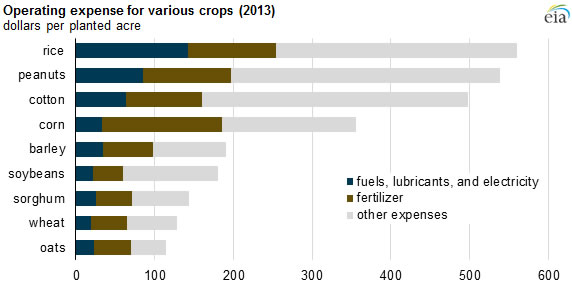 |
Agricultural energy consumption includes both direct and indirect energy consumption. Direct energy consumption includes the use of diesel, electricity, propane, natural gas and renewable fuels for activities on the farm. Indirect energy consumption includes the use of fuel and feedstock — especially natural gas — in the manufacturing of agricultural chemicals such as fertilizers and pesticides.
Energy makes up a significant part of operating expenditures for most crops, especially when considering indirect energy expenditures on fertilizer, because the production of fertilizer is extremely energy-intensive, requiring large amounts of natural gas. For some crops like oats, corn, wheat and barley, energy and fertilizer expenditures combined make up more than half of total operating expenses. The proportion of direct to indirect energy use varies by crop. For example, corn, which is also used as an energy input for ethanol production, has relatively low direct fuel expenditures but has the highest percentage of fertilizer expenditures.
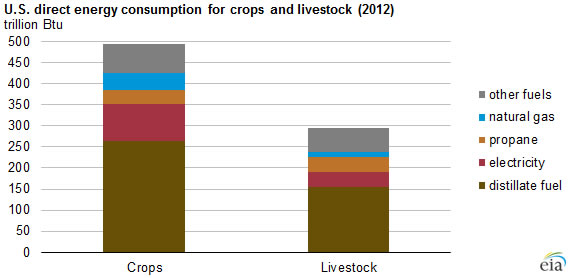 |
Distillate fuel, or diesel, is the dominant fuel for direct energy consumption for both livestock and crop operations. Distillate is used for crop tilling, harvesting, weed control and other operations that require heavy machinery. Crop drying is another fuel-intensive farm activity, and the amount of fuel used varies by the type of crop and its moisture content. High-temperature dryers are powered by either electricity or propane.
Supplying water can also be an energy-intensive task. Although some farms have access to public water supplies, most farms pump water from wells and groundwater sources. Most pumping is done with electricity, but pumps in remote locations may use diesel or propane.
The chemicals used by the agricultural industry are a subset of the bulk chemical industry and include fertilizers and pesticides. Nitrogenous (ammonia-based) fertilizers require large amounts of natural gas as a feedstock and provide heat and power for processing. The Energy Information Administration's 2010 Manufacturing Energy Consumption Survey estimates that the U.S. nitrogenous fertilizer industry consumed more than 200 trillion British thermal units of natural gas as feedstock in 2010 and another 152 trillion units for heat and power.
In addition to being major energy consumers, some farms are using renewable resources to produce energy. Wind turbines, methane digesters and photovoltaics are the most common on-farm renewables. Renewable energy can help to offset the need for purchased energy. In some cases, the renewable energy produced on farms is sold to electric power suppliers, providing additional income for farmers.
Soil — Where It All Begins
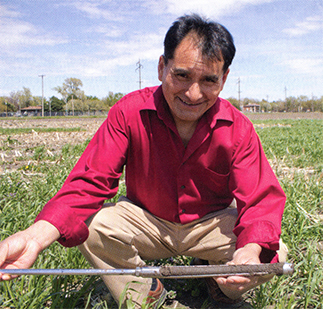 Asst. Professor of Agronomy and Horticulture, Humberto Blanco, University of Nebraska - Lincoln |
by Mary Garbacz
Soil is the basis not only for crops, but for humanity. Soil grows crops, provides feed for animals and feed-stock for energy. Soil cleans the water and the air; it filters runoff. Soil provides the ecosystem services that clean the environment. Soil is a living ecosystem, with billions of organisms in every tablespoon.
University of Nebraska-Lincoln Assistant Professor of Agronomy and Horticulture, Humberto Blanco, grew up on a farm in the highlands of Bolivia. The soils are different there, 12,000 feet above sea level. But Blanco's father knew the soil. He would scoop up a handful of soil, feel it and smell it and pronounce it ready to receive the seeds that would produce the crops.
"We didn't use any special tests or techniques to analyze the soil," Blanco said. His father's basic "feel and smell" test detected the organic matter in the soil, as well as the soil structure. It also led to Blanco's lifelong intrigue with the physical, chemical and biological properties of the soil that sustains life.
Today, Blanco is an applied soil physicist. He studies basic soil processes and properties in short-term and long-term experiments, to better understand how different management practices affect soils, which are the basis for crops that feed the world. Soil provides ecosystems services that regulate water flow, gas flux and air quality.
Soil transforms residues above and below the surface into nutrients — it even stores those nutrients. Soil structure provides support for plants and their roots.
In the past, researchers studied soils based on just a few properties or discipline-based views. But as scientists learned more about soils, they expanded their studies, bringing in the perspectives and knowledge of researchers in different disciplines including agricultural engineering, soil hydrology, soil genesis, soil chemistry, soil microbiology, soil physics, plant science and others.
"We need to work together if we want to manage soils from a holistic point of view," he said. "We want to improve soil ecosystem services. It goes back to not only producing more food, but to improving the environment."
Providing Food Through Technology
Technology in the study of soils can be management practices, such as conservation tillage; it can be the use of cover crops to reduce soil erosion or add organic matter to the soil; it can be the way crop residues are managed. "Technology in soil science includes careful management so that nothing negatively affects the soil or damages the environment," Blanco said, "so that sustained agricultural production is assured."
"The challenge is that we have to produce more food, more feed for animals, more fiber, more fuel with less land, less energy and probably, with less fertilizer," Blanco said. "So achieving sustainability will require that we improve current management practices."
"As researchers, we talk about soil response to man-agement based on the soil physical, chemical and biological processes and properties then say, 'this management practice improves soils — we should adopt it'. It may not be that simple. What about economics?" Blanco said.
Adoption of new techniques may take time and may have to be proven to be profitable.
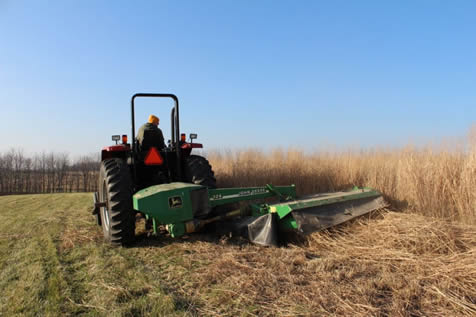 Mowing cover crop for bailing |
"It has evolved," Blanco said. Since the Dust Bowl of the 1930s, conservation tillage practices have been gradually adopted that can help reduce wind erosion. "Now, no-till and reduced-till are more common than at that time. Conservation tillage is better than conventional tillage," he said. Leaving crop residue on the soil surface protects the soil from erosion and adds organic matter to the soil and sustains crop production, among other benefits. "For example, about 25 percent of the cultivated area is under no-till in the United States and no-till is even more popular in other countries, such as Brazil, Paraguay and Argentina," Blanco said.
The Underground World of Cover Crops
Cover crops are plants that are grown specifically to cover the soil, protecting the soil against water and wind erosion. Cover crops, act like blankets on the soil, but also improve the quality of soil, water and air. Cover crops provide organic matter content, recycle nutrients and, with their roots as a mechanism, improve the soil structure so water will move into the soil quickly and have greater water-holding capacity. That water-holding capacity keeps the water in the soil for use by the crops. Management practices that increase soil organic matter will increase the ability of the soil to hold water. Addition of cover crops to conventional systems especially increases the amount of below-ground biomass (root biomass) this is key for improving soil structure and biology. "As a result, cover crops feed the soil that feeds us," he said. Blanco said cover crops can add nutrients to the soil and reduce the use of inorganic fertilizers. Cover crops could become a more economical choice than addition of inorganic fertilizers if costs continue to increase. "There has to be a balance there," he said. With increased production come concerns about soil and water quality, including erosion caused by wind and water, as well as nitrogen leaching. Each cover crop provides different benefits to the soil. The decision of which cover crop to plant depends on the goal, Blanco said: coverage for the soil surface; addition of nitrogen to the soil; or reducing soil compaction.
 Rye cover crop |
Legumes, he said, such as soybeans, will not provide the same coverage of the soil surface as winter rye, but legumes improve soil fertility, adding nitrogen to the soil.
Brassica, Blanco said, is a category of root vegetables with long tap roots, including turnips and radishes. The tap roots penetrate into the soil and fix compaction problems that may have resulted from the use of heavy equipment. These roots can grow deep into the soil, increasing infiltration of water and recycling nutrients.
Cover Crops as Livestock Feed
Another use of cover crops, Blanco said, is that livestock could graze the hay or the crop residue, depending on the cover crop, "which can be broadly appealing", he added.
"Nebraska is number one nationally in livestock production", Blanco said, "so providing feed for animals is a top priority."
In dry years, such as the drought year of 2012, animal forage and feed were in short supply. In the absence of traditional feeds, farmers baled residue corn stover and even wheat straw to feed their animals. "Cover crops can provide some feed resources", Blanco said.
But because grazing or haying cover crops reduces the surface cover, it may reduce the soil benefits of cover crops.
More research needs to be done on using cover crops for haying, Blanco said. "We need to make our decisions on solid research data," he said. He currently is assessing how soil responds to grazing of cover crops.
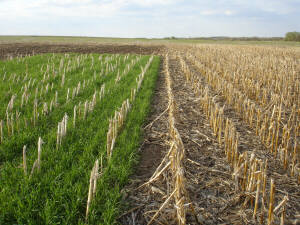 Rye cover crop field test |
Crop residues contain about 50 percent carbon, he said, and organic carbon in the soil is key to other soil properties, such as soil structure. Soil structure affects water flow, water infiltration, water runoff and the porosity of the soil, Blanco said. If the soil structure is not well-developed, it probably will not allow the support that plant roots need.
"Although the main use for crop residues is to protect the soil or maintain soil properties, the residues now have found new uses," Blanco said. Cellulose is the main structure of plants and has been used in the production of cellulosic biofuels. Distillers grains, a co-product of corn ethanol production, are mixed with corn residues and used for animal feed.
"In some cases, we do have large amounts of residue so removing a fraction of residue produced may be feasible, but the amount of residue that is available for removal depends on soil type, management and cropping system," Blanco said. Irrigated farmland that grows an abundance of crop residues may be able to spare some of that abundance for fuel production. Rainfed, or dryland farmland may need that residue to protect and sustain the soil.
Blanco said it is important to consider that cover crops can play a role in lessening possible negative impacts of residue removal on the soils. Planting cover crops after the residue is baled can be an option, he added.
Recent on-farm experiments UNL is conducting are studying crop residue grazing and baling in fields with and without cover crops in relation to the implication on soil compaction, erosion, nutrient cycling and crop yields.
 Cover crops add nutrients and help retain soil moisture |
Research takes time, which is why much research takes place in educational institutions.
As a faculty member at Kansas State University, Blanco took part in a nitrogen fertilization experiment that had been ongoing for 50 years. "Fifty years and longer can provide valuable research information that shows how certain practices affect the soil in the long-term," Blanco said. The research goal was to see how inorganic fertilizers affected soil properties. Blanco conducted similar work in Nebraska using long-term experiments.
The purpose of applying fertilizer is to increase crop yield, he said, which at the same time increases crop residue amount. "We know nitrogen will not directly improve soils, but it may positively influence soil by increasing crop residue," Blanco said. But the applications must be the right amounts to reduce losses and any possible negative effects on soil and environment. Research has shown that if producers apply about 80 pounds of nitrogen per acre, there will not be any negative effects, he added.
Nebraska — The place for Research
"Nebraska is a great place to conduct research," Blanco said. Western Nebraska receives less precipitation than does the eastern part of the state, so Blanco and his colleagues are starting soil experiments along the precipitation gradient across the state. The result is new knowledge that can be shared not only with Nebraska producers, but with others in the U.S. and other countries that have similar soils and similar precipitation.
Blanco also is pursuing funding opportunities to take research to a regional scale, looking at how soil responds to different management practices such as cover crops, crop residue management and others, under diverse climatic conditions across a precipitation and evapotranspiration gradient in the Central Great Plains. "It (evapotranspiration) changes from north to south, like precipitation changes from east to west," he said. "That's an opportunity to study interactions among agro-ecosystems, climate and soils."